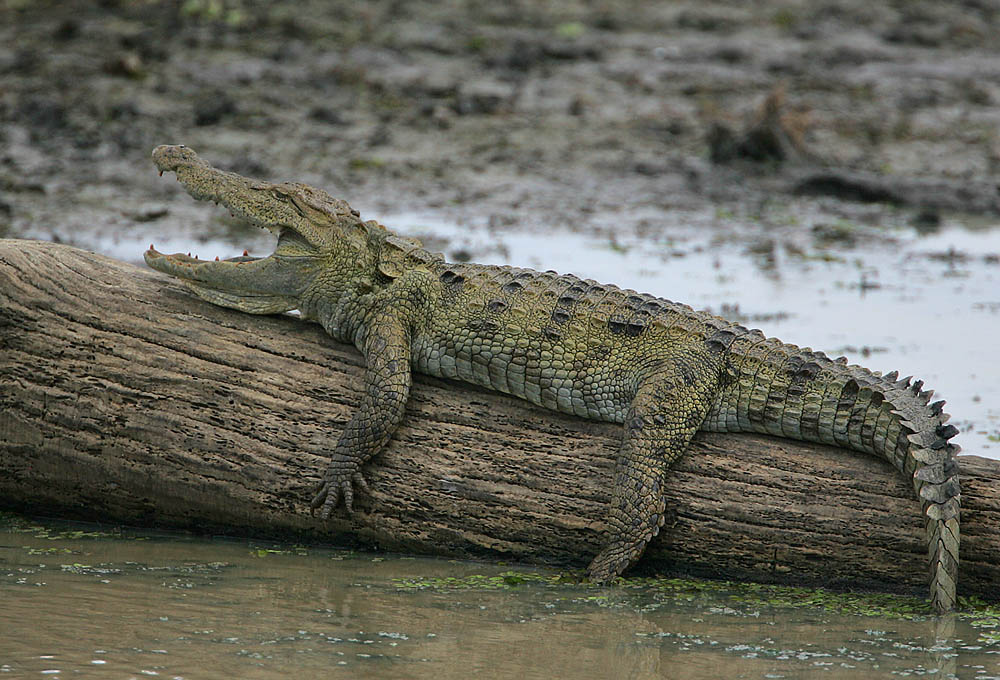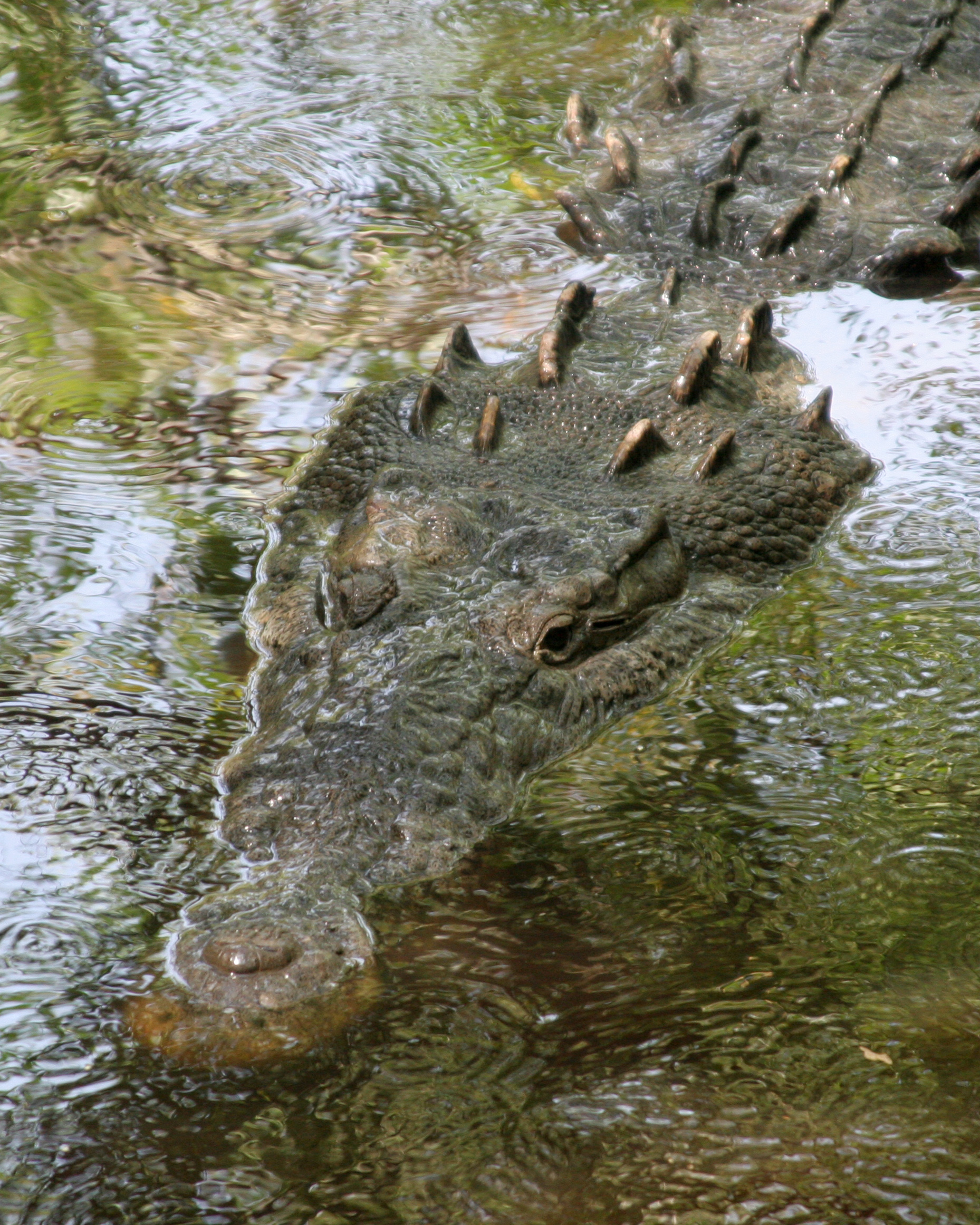|
West African Crocodile
The West African crocodile, desert crocodile, or sacred crocodile (''Crocodylus suchus'') is a species of crocodile related to – and often confused with – the larger and more aggressive Nile crocodile (''C. niloticus''). Taxonomy Compared to the Nile crocodile, the West African crocodile is smaller: Adults are typically long, and maximum is perhaps . The species was named by Étienne Geoffroy Saint-Hilaire in 1807, who discovered differences between the skulls of a mummified crocodile and those of Nile crocodile (''C. niloticus''). This new species was, however, for a long time afterwards regarded as a Synonym (taxonomy), synonym of the Nile crocodile. In 2003, a study indicated that ''C. suchus'' was a valid species, and this was confirmed by several other studies in 2011–2015. Despite the long history of confusion, Genetics, genetic testing has revealed that the two are not particularly close. The closest relatives of the Nile crocodile are the ''Crocodylus'' species fr ... [...More Info...] [...Related Items...] OR: [Wikipedia] [Google] [Baidu] |
Stratigraphic
Stratigraphy is a branch of geology concerned with the study of rock layers (strata) and layering (stratification). It is primarily used in the study of sedimentary and layered volcanic rocks. Stratigraphy has three related subfields: lithostratigraphy (lithologic stratigraphy), biostratigraphy (biologic stratigraphy), and chronostratigraphy (stratigraphy by age). Historical development Catholic priest Nicholas Steno established the theoretical basis for stratigraphy when he introduced the law of superposition, the principle of original horizontality and the principle of lateral continuity in a 1669 work on the fossilization of organic remains in layers of sediment. The first practical large-scale application of stratigraphy was by William Smith in the 1790s and early 19th century. Known as the "Father of English geology", Smith recognized the significance of strata or rock layering and the importance of fossil markers for correlating strata; he created the first geologic map o ... [...More Info...] [...Related Items...] OR: [Wikipedia] [Google] [Baidu] |
Crocodylus Porosus White Background
''Crocodylus'' is a genus of true crocodiles in the family Crocodylidae. Taxonomy The generic name, ''Crocodylus'', was proposed by Josephus Nicolaus Laurenti in 1768. ''Crocodylus'' contains 13–14 extant (living) species and 5 extinct species. There are additional extinct species attributed to the genus ''Crocodylus'' that studies have shown no longer belong, although they have not yet been reassigned to new genera. Extant species The 13–14 living species are: Fossils ''Crocodylus'' also includes five extinct species: * † '' Crocodylus anthropophagus'' is an extinct crocodile from Plio-Pleistocene of Tanzania. * † ''Crocodylus checchiai'' is an extinct crocodile from Late Miocene of Kenya. * † '' Crocodylus falconensis'' is an extinct crocodile from Early Pliocene of Venezuela. * † '' Crocodylus palaeindicus'' is an extinct crocodile the Miocene to the Pleistocene of southern Asia. * † ''Crocodylus thorbjarnarsoni'' is an extinct crocodile from Plio-Pleist ... [...More Info...] [...Related Items...] OR: [Wikipedia] [Google] [Baidu] |
Saltwater Crocodile
The saltwater crocodile (''Crocodylus porosus'') is a crocodilian native to saltwater habitats and brackish wetlands from India's east coast across Southeast Asia and the Sundaic region to northern Australia and Micronesia. It has been listed as Least Concern on the IUCN Red List since 1996. It was hunted for its skin throughout its range up to the 1970s, and is threatened by illegal killing and habitat loss. It is regarded as dangerous to humans. The saltwater crocodile is considered to be the largest living reptile. Males can grow up to a length of , rarely exceeding , and a weight of . Females are much smaller and rarely surpass . It is also called the estuarine crocodile, Indo-Pacific crocodile, marine crocodile, sea crocodile, and informally as the saltie. A large and opportunistic hypercarnivorous apex predator, they ambush most of their prey and then drown or swallow it whole. They are capable of prevailing over almost any animal that enters their territory, including ... [...More Info...] [...Related Items...] OR: [Wikipedia] [Google] [Baidu] |
Philippine Crocodile
The Philippine crocodile (''Crocodylus mindorensis''), also known as the Mindoro crocodile, the Philippine freshwater crocodile, the ''bukarot'' in Ilocano, and more generally as a ''buwaya'' in most Filipino lowland cultures, is one of two species of crocodiles found in the Philippines; the other is the larger saltwater crocodile ''(Crocodylus porosus)''. The Philippine crocodile, the species endemic only to the country, went from data deficient to critically endangered in 2008 from exploitation and unsustainable fishing methods, such as dynamite fishing. Conservation methods are being taken by the Dutch/Filipino Mabuwaya foundation,"Philippine Crocodile Comeback" . cepf.net. Retrieved on 2007-10-22. the Crocodile Conservation Society and the Zoological Institute of HerpaWorld in |
New Guinea Crocodile
The New Guinea crocodile (''Crocodylus novaeguineae'') is a small species of crocodile found on the island of New Guinea north of the mountain ridge that runs along the centre of the island. The population found south of the mountain ridge, formerly considered a genetically distinct population, is now considered a distinct species, Hall's New Guinea crocodile (''C. halli''). In the past it included the Philippine crocodile, ''C. n. mindorensis'', as a subspecies, but today they are regarded as separate species. The habitat of the New Guinea crocodile is mostly freshwater swamps and lakes. It is most active at night when it feeds on fish and a range of other small animals. A female crocodile lays a clutch of eggs in a nest composed of vegetation and she lies up nearby to guard the nest. There is some degree of parental care for newly hatched juveniles. This crocodile was over-hunted for its valuable skin in the mid 20th century, but conservation measures have since been put in plac ... [...More Info...] [...Related Items...] OR: [Wikipedia] [Google] [Baidu] |
Freshwater Crocodile White Background
Fresh water or freshwater is any naturally occurring liquid or frozen water containing low concentrations of dissolved salts and other total dissolved solids. Although the term specifically excludes seawater and brackish water, it does include non- salty mineral-rich waters such as chalybeate springs. Fresh water may encompass frozen and meltwater in ice sheets, ice caps, glaciers, snowfields and icebergs, natural precipitations such as rainfall, snowfall, hail/ sleet and graupel, and surface runoffs that form inland bodies of water such as wetlands, ponds, lakes, rivers, streams, as well as groundwater contained in aquifers, subterranean rivers and lakes. Fresh water is the water resource that is of the most and immediate use to humans. Water is critical to the survival of all living organisms. Many organisms can thrive on salt water, but the great majority of higher plants and most insects, amphibians, reptiles, mammals and birds need fresh water to survive. ... [...More Info...] [...Related Items...] OR: [Wikipedia] [Google] [Baidu] |
Freshwater Crocodile
The freshwater crocodile (''Crocodylus johnstoni''), also known as the Australian freshwater crocodile, Johnstone's crocodile or the freshie, is a species of crocodile endemic to the northern regions of Australia. Unlike their much larger Australian relative, the saltwater crocodile, freshwater crocodiles are not known as man-eaters, although they bite in self-defence, and brief, nonfatal attacks have occurred, apparently the result of mistaken identity. Taxonomy and etymology When Gerard Krefft named the species in 1873, he intended to commemorate the man who first reported it to him, Australian native police officer and amateur naturalist Robert Arthur Johnstone (1843–1905). However, Krefft made an error in writing the name, and for many years, the species has been known as ''C. johnsoni''. Recent studies of Krefft's papers have determined the correct spelling of the name, and much of the literature has been updated to the correct usage, but both versions still exist. Accor ... [...More Info...] [...Related Items...] OR: [Wikipedia] [Google] [Baidu] |
Crocodylus Palaeindicus
''Crocodylus palaeindicus'' is an extinct species of crocodile from southern Asia. ''C. palaeindicus'' lived from the Miocene to the Pliocene. It may be an ancestor of the living Mugger crocodile. History ''C. palaeindicus'' was first named by Scottish paleontologist Hugh Falconer in 1859. Falconer found fossils of the species in the Siwalik Hills of India along with the remains of many other animals like turtles, ostriches, camels, saber-toothed cats, mastodons. Richard Lydekker later named another crocodile from the Siwalik Hills which he called ''C. sivalensis''. Although the two crocodiles are very similar, ''C. sivalensis'' was distinguished from ''C. palaeindicus'' because the margin of its skull was less convex. ''C. sivalensis'' has recently been synonymized with ''C. palaeindicus'', as the slight differences in shape are thought to be from natural variation or from fossilization. In later years, fossils were also found from Pakistan and Myanmar. Classification Histori ... [...More Info...] [...Related Items...] OR: [Wikipedia] [Google] [Baidu] |
Crocodylus Thorbjarnarsoni
''Crocodylus thorbjarnarsoni'' is an extinct species of crocodile from the Pliocene and Pleistocene of the Turkana Basin in Kenya. It is closely related to the species ''Crocodylus anthropophagus'', which lived during the same time in Tanzania. ''C. thorbjarnarsoni'' could be the largest known true crocodile, with the largest skull found indicating a possible total length up to . It may have been a predator of early hominins. ''Crocodylus thorbjarnarsoni'' was named by Christopher Brochu and Glenn Storrs in 2012 in honor of John Thorbjarnarson, a conservationist who worked to protect endangered crocodilians. Description ''Crocodylus thorbjarnarsoni'' is distinguished from other crocodiles by its broad snout. It has small raised rims on the prefrontal bones in front of the eyes, a feature also seen in some Nile crocodile individuals. The squamosal bones form raised rims along the sides of the skull table, similar to the crests in ''C. anthropophagus'' but much smaller. ... [...More Info...] [...Related Items...] OR: [Wikipedia] [Google] [Baidu] |
Crocodylus Anthropophagus
''Crocodylus anthropophagus'' is an extinct species of crocodile from the Pleistocene of Tanzania. It lived 1.84 million years ago. It was a large-sized predator reaching a length of . Etymology ''Crocodylus anthropophagus'' was first named by Christopher A. Brochu, Jackson Njau, Robert J. Blumenschine and Llewellyn D. Densmore in 2010. The specific name ''anthropophagus'' is from Greek word "''anthropos''" that means "human" and Greek word "'" that means "eater", in reference to the evidence that this animal included hominids in its diet. Taxonomy The holotype specimen, NNHM-1001, comprises a skull and partial skeleton. All specimens were discovered in Olduvai Gorge, Tanzania, in two different rock formations dating to 1.845 and 1.839 million years ago in the Plio-Pleistocene. The cladogram below is from a 2021 study based on the finding of a new ''C. anthropophagus'' partial cranium. Description The skeleton is consistent with living representatives of the genus. The a ... [...More Info...] [...Related Items...] OR: [Wikipedia] [Google] [Baidu] |
Crocodylinae
Crocodylinae is a subfamily of true crocodiles within the family Crocodylidae, and is the sister taxon to Osteolaeminae ( dwarf crocodiles and slender-snouted crocodiles). Taxonomy Crocodylinae was cladistically defined by Christopher Brochu in 1999 as ''Crocodylus niloticus'' (the Nile crocodile) and all crocodylians more closely related to it than to ''Osteolaemus tetraspis'' (the Dwarf crocodile). This is a stem-based definition, and is the sister taxon to Osteolaeminae. Crocodylinae contains the extant genus '' Crocodylus''. It is disputed as to whether is also includes ''Mecistops'' (slender-snouted crocodiles), or the extinct genus Voay. Phylogeny Some morphological studies have recovered ''Mecistops'' as a basal member of Crocodylinae, more closely related to '' Crocodylus'' than to ''Osteolaemus'' and the other members of Osteolaeminae, as shown in the cladogram below. The below cladogram is based on a 2021 study using paleogenomics that extracted DNA from the ext ... [...More Info...] [...Related Items...] OR: [Wikipedia] [Google] [Baidu] |

%2C_NPSPhoto_(9255693421).jpg)




